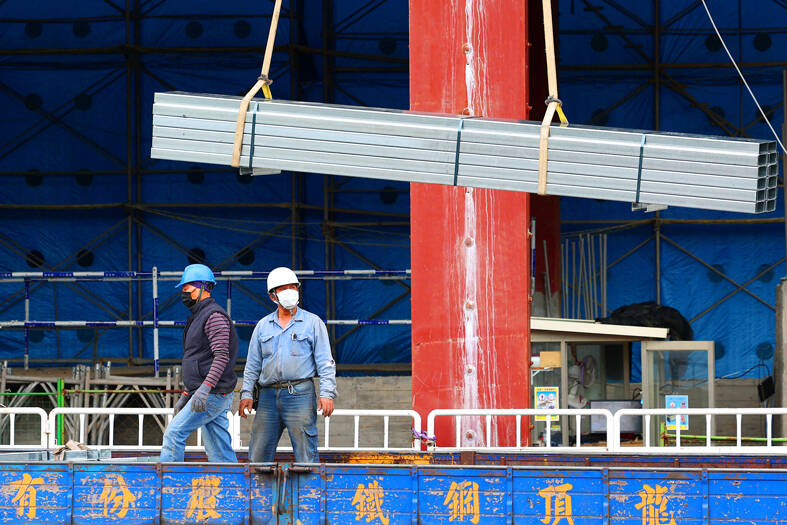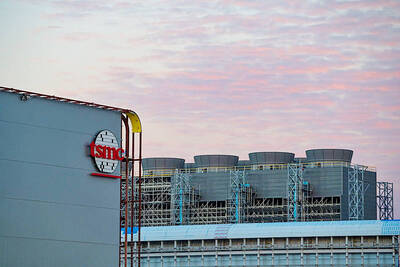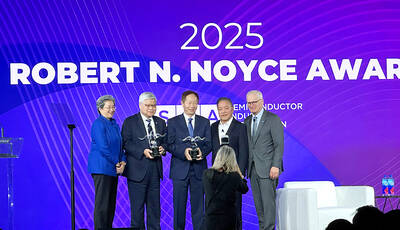Cathay Financial Holding Co (國泰金控) yesterday downgraded its GDP growth forecast for Taiwan for this year to 3.0 percent, from its previous estimate of 3.2 percent, and lowered its forecast to 2.3 percent for next year, down from 2.7 percent, citing slowing export and investment growth.
Other factors that could also weigh on the nation’s growth outlook include Russia’s invasion of Ukraine, China’s COVID-19 situation and inflation in the US and Europe, Cathay Financial Holding said.
Since the global economy is expected to slow next year, demand for manufactured goods from Taiwan might weaken, which would add to the pressure on electronics manufacturers facing inventory congestion and dampen exports momentum, said National Central University economics professor Hsu Chih-chiang (徐之強), who heads a research team commissioned by Cathay Financial Holding.

Photo: CNA
As companies become more conservative about exports and economic growth, they might refrain from expanding or making large-scale investments next year to avoid affecting the scale of private investment, Hsu said.
On a positive note, private consumption might contribute to the economy next year due to increased purchasing and relaxed border controls, he said.
In addition, growth momentum in the second half of next year might be stronger than in the first half, as firms are likely to have depleted their inventories by then, Hsu said.
Cathay Financial Holding’s 2.3 percent GDP growth forecast is lower than the 2.53 percent estimate by the central bank and the 2.75 percent that the Directorate-General of Budget, Accounting and Statistics predicted.
Inflation in Taiwan is expected to peak at about 2.0 percent at the end of first quarter next year and the central bank could stop its rate hikes in the first half of the year, Hsu said.
There is a slim chance that the central bank would lower its policy rates next year, he said.
The policy rates are still at a comparatively low level given the central bank’s mild pace of hikes this year, he added.

Shiina Ito has had fewer Chinese customers at her Tokyo jewelry shop since Beijing issued a travel warning in the wake of a diplomatic spat, but she said she was not concerned. A souring of Tokyo-Beijing relations this month, following remarks by Japanese Prime Minister Sanae Takaichi about Taiwan, has fueled concerns about the impact on the ritzy boutiques, noodle joints and hotels where holidaymakers spend their cash. However, businesses in Tokyo largely shrugged off any anxiety. “Since there are fewer Chinese customers, it’s become a bit easier for Japanese shoppers to visit, so our sales haven’t really dropped,” Ito

The number of Taiwanese working in the US rose to a record high of 137,000 last year, driven largely by Taiwan Semiconductor Manufacturing Co’s (TSMC, 台積電) rapid overseas expansion, according to government data released yesterday. A total of 666,000 Taiwanese nationals were employed abroad last year, an increase of 45,000 from 2023 and the highest level since the COVID-19 pandemic, data from the Directorate-General of Budget, Accounting and Statistics (DGBAS) showed. Overseas employment had steadily increased between 2009 and 2019, peaking at 739,000, before plunging to 319,000 in 2021 amid US-China trade tensions, global supply chain shifts, reshoring by Taiwanese companies and

Taiwan Semiconductor Manufacturing Co (TSMC, 台積電) received about NT$147 billion (US$4.71 billion) in subsidies from the US, Japanese, German and Chinese governments over the past two years for its global expansion. Financial data compiled by the world’s largest contract chipmaker showed the company secured NT$4.77 billion in subsidies from the governments in the third quarter, bringing the total for the first three quarters of the year to about NT$71.9 billion. Along with the NT$75.16 billion in financial aid TSMC received last year, the chipmaker obtained NT$147 billion in subsidies in almost two years, the data showed. The subsidies received by its subsidiaries —

Taiwan Semiconductor Manufacturing Co (TSMC) Chairman C.C. Wei (魏哲家) and the company’s former chairman, Mark Liu (劉德音), both received the Robert N. Noyce Award -- the semiconductor industry’s highest honor -- in San Jose, California, on Thursday (local time). Speaking at the award event, Liu, who retired last year, expressed gratitude to his wife, his dissertation advisor at the University of California, Berkeley, his supervisors at AT&T Bell Laboratories -- where he worked on optical fiber communication systems before joining TSMC, TSMC partners, and industry colleagues. Liu said that working alongside TSMC